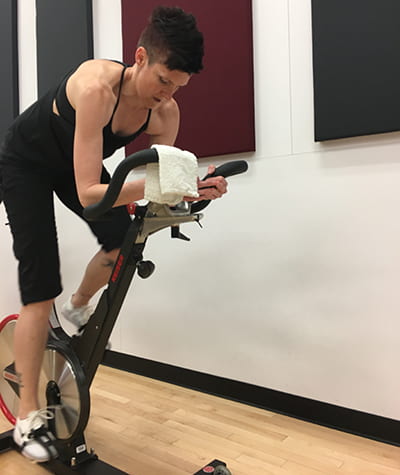The fall and winter months can be busy times for people. Gone are the days of barbecues and summer vacations, but very quickly the holiday seasons begin.  With these things happening all at once, our health and wellness sometimes takes a back seat due to time constraints. With that in mind, here are a few changes to your workout program that you can make during periods where time is of the essence:
With these things happening all at once, our health and wellness sometimes takes a back seat due to time constraints. With that in mind, here are a few changes to your workout program that you can make during periods where time is of the essence:
- Structure Intervals in your cardiovascular exercise.
- Intervals allow us to have a more intense workout in the same amount of time or less. If we are accustomed to doing 60 min of cardiovascular exercise at an intensity of 50% max heart rate, try changing up the intensity and duration to something like this:
- 11 x (2 min @ 80% + 2 min @ 60%) = 44 min X 70% HR Average Total Volume= 8
- 60 min @ 50% max heart rate = 60 X .5 Total Volume = 30
- Jump on a treadmill, elliptical, spin bike, any cardio equipment that allows you to monitor your heart rate.
- So it’s possible for us to achieve the same amount of work in 16 minutes less by increasing the intensity and decreasing the duration.
- Intervals allow us to have a more intense workout in the same amount of time or less. If we are accustomed to doing 60 min of cardiovascular exercise at an intensity of 50% max heart rate, try changing up the intensity and duration to something like this:
- Performing 2 or more exercises in succession with little or no rest between
- “Super-sets” or “compound-sets” means performing two or more exercises with little to no rest, either with the same muscle group (compound-set) or opposing muscle groups (super-set). A sample super-set would be bench press (chest) followed by a row (back) and a compound-set would be two pressing or two pulling exercises, so a squat (quads) and lunge (hamstrings). By minimizing the rest time between exercises, we pack the same amount of work into a smaller amount of time or more work into the same amount of time.
I’m too stressed – training smart
During these times of transition and change, it is not uncommon for people to feel under more stress than usual. Unfortunately, this often means missing workouts or getting “burnt out” trying to do too much during these stressful periods. In both instances, we usually return to the gym feeling like we’re starting all over again or that we’ve lost a lot of the progress that we made prior to being away. The challenge becomes finding ways to do enough training to maintain a level of fitness, but not so much that we burn out and have to miss time due to illness, injury etc.
Stress is not a foreign concept to resistance training – on the contrary, it is actually a central part of planning. For as long as strength training has been a “thing”, coaches and athletes have implemented periods of less stressful training immediately following periods of increased stress – a variation of this is called a “taper”. Essentially a taper is used to allow the athlete to adapt to periods of intense training so that they are peaked for competition – the point at which other sources of stress become more of a factor – travel, sleep disturbances, anxiety about performance etc. The good news for those of us who are training for other reasons than peaking for a competition is all of the variables used to create those periods of decreased stress exist in all exercise programs.
In strength training, coaches manipulate the frequency, intensity, and/or volume of training to allow the athlete to cope with the increased stress that they just experienced or are experiencing. In simple terms this can mean decreasing the amount of training sessions in a given period (frequency), the load used for a given set and repetition combination (intensity), or even decreasing the amount of repetitions done for a given weight (volume).
Reducing the number or duration of your workouts strategically can help free up your time to take care of yourself when experiencing too much stress in your life. So, you might not need those lotions, Zen gardens, diffusers or stress balls, as the remedy for your stress might just be re-structuring what you already do!
Check out another reason to keep active
by Devin Clayton
Devin is a Bachelors of Physical Education graduate from the University of Alberta. He is a Certified Strength and Conditioning Specialist through the NSCA and is a NCCP certified Weightlifting coach.

